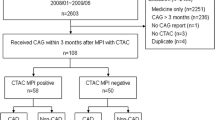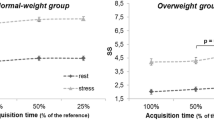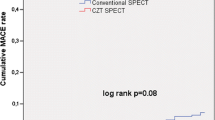Abstract
Purpose
In clinical myocardial single photon emission computed tomography (SPECT), attenuation artefacts may cause a loss of specificity in the identification of diseased vessels that can be corrected by means of gated SPECT (GSPECT) acquisition or CT attenuation correction (AC). The purpose of this multicentre study was to assess the impact of GSPECT and AC on the diagnostic performance of myocardial scintigraphy, according to patient’s sex, body mass index (BMI) and site of coronary artery disease (CAD).
Methods
We studied a group of 104 patients who underwent coronary angiography within 1 month before or after the SPECT study. Patients with a BMI > 27 were considered “overweight”. Attenuation-corrected and standard GSPECT early images were randomly interpreted by three readers blinded to the clinical data.
Results
In the whole group, GSPECT and AC showed a diagnostic accuracy of 86.5% (sensitivity 82%, specificity 93%) and 77% (sensitivity 75.4%, specificity 81.4%), respectively (p < 0.05). In women, when anterior ischaemia was matched with CAD, AC failed to show any increase in specificity (AC 63.6% vs GSPECT 63.6%) with evident loss of sensitivity (AC 72.7% vs GSPECT 90.9%). AC significantly improved SPECT specificity in the identification of right CAD in overweight men (AC 100% vs GSPECT 66.7%, p <0.05).
Conclusion
AC improved specificity in the evaluation of right CAD in overweight men. In the other evaluable subgroups specificity was not significantly affected while sensitivity was frequently reduced.



Similar content being viewed by others
References
Maddahi J, Kiat H, Van Train KF, Prigent F, Friedman J, Garcia EV, et al. Myocardial perfusion imaging with technetium-99m sestamibi SPECT in the evaluation of coronary artery disease. Am J Cardiol 1990;66:55E–62.
Palmas W, Bingham S, Diamond GA, Denton TA, Kiat H, Friedman JD, et al. Incremental prognostic value of exercise thallium-201 myocardial single-photon emission computed tomography late after coronary artery bypass surgery. J Am Coll Cardiol 1995;25:403–9.
Nallamothu N, Johnson JH, Bagheri B, Heo J, Iskandrian AE. Utility of stress single-photon emission computed tomography (SPECT) perfusion imaging in predicting outcome after coronary artery bypass grafting. Am J Cardiol 1997;80:1517–21.
Kósa I, Blasini R, Schneider-Eicke J, Neumann FJ, Matsunari I, Neverve J, et al. Myocardial perfusion scintigraphy to evaluate patients after coronary stent implantation. J Nucl Med 1998;39:1307–11.
Fleishmann S, Koepfli P, Namdar M, Wyss CA, Jenni R, Kaufmann PA. Gated (99m)Tc-tetrofosmin SPECT for discriminating infarct from artifact in fixed myocardial perfusion defects. J Nucl Med 2004;45:754–9.
He ZX, Scarlett MD, Mahmarian JJ, Verani MS. Enhanced accuracy of defect detection by myocardial single-photon emission computed tomography with attenuation correction with gadolinium 153 line sources: evaluation with a cardiac phantom. J Nucl Cardiol 1997;4:202–10.
Kluge R, Sattler B, Seese A, Knapp WH. Attenuation correction by simultaneous emission-transmission myocardial single-photon emission tomography using a technetium-99m-labelled radiotracer: impact on diagnostic accuracy. Eur J Nucl Med 1997;24:1107–14.
Patton JA, Townsend DW, Hutton BF. Hybrid imaging technology: from dreams and vision to clinical devices. Semin Nucl Med 2009;39(4):247–63.
Thompson RC, Heller GV, Johnson LL, Case JA, Cullom SJ, Garcia EV, et al. Value of attenuation correction on ECG-gated SPECT myocardial perfusion imaging related to body mass index. J Nucl Cardiol 2005;12:195–202.
Wolak A, Slomka PJ, Fish MB, Lorenzo S, Berman DS, Germano G. Quantitative diagnostic performance of myocardial perfusion SPECT with attenuation correction in women. J Nucl Med 2008;49:915–22.
Banzo I, Pena FJ, Allende RH, Quirce R, Carril JM. Prospective clinical comparison of non-corrected and attenuation- and scatter-corrected myocardial perfusion SPECT in patients with suspicion of coronary artery disease. Nucl Med Commun 2003;24:995–1002.
Garcia EV. SPECT attenuation correction: an essential tool to realize nuclear cardiology’s manifest destiny. J Nucl Cardiol 2007;14:16–24.
Bray GA. Overweight is risking fate. Definition, classification, prevalence, and risks. Ann N Y Acad Sci 1987;499:14–28.
Hesse B, Tägil K, Cuocolo A, Anagnostopoulos C, Bardiés M, Bax J, et al. EANM/ESC procedural guidelines for myocardial perfusion imaging in nuclear cardiology. Eur J Nucl Med Mol Imaging 2005;32:855–97.
Giorgetti A, Rossi M, Stanislao M, Valle G, Bertolaccini P, Maneschi A, et al. Feasibility and diagnostic accuracy of gated SPECT early-imaging protocol: a multicenter study of the Myoview Imaging Optimization Group. J Nucl Med 2007;48:1670–5.
Cerqueira MD, Weissman NJ, Dilsizian V, Jacobs AK, Kaul S, Laskey WK, et al. Standardized myocardial segmentation and nomenclature for tomographic imaging of the heart: a statement for healthcare professionals from the Cardiac Imaging Committee of the Council on Clinical Cardiology of the American Heart Association. J Nucl Cardiol 2002;9:240–5.
Germano G, Kavanagh PB, Waechter P, Areeda J, Van Kriekinge S, Sharir T, et al. A new algorithm for the quantitation of myocardial perfusion SPECT. I: technical principles and reproducibility. J Nucl Med 2000;41:712–9.
Bland JM, Altman DG. Statistical methods for assessing agreement between two methods of clinical assessment. Lancet 1986;1:307–10.
Metz CE. Basic principles of ROC analysis. Semin Nucl Med 1978;8:283–98.
Fleiss J. Statistical methods for rates and proportions. 2nd ed. New York: Wiley & Sons; 1981.
Gregoriou GK, Tsui BM, Gullberg GT. Effect of truncated projections on defect detection in attenuation-compensated fanbeam cardiac SPECT. J Nucl Med 1998;39:166–75.
Takahashi Y, Murase K, Higashino H, Mochizuki T, Motomura N. Attenuation correction of myocardial SPECT images with X-ray CT: effects of registration errors between X-ray CT and SPECT. Ann Nucl Med 2002;16:431–5.
Ficaro EP, Fessler JA, Ackermann RJ, Rogers WL, Corbett JR, Schwaiger M. Simultaneous transmission-emission thallium-201 cardiac SPECT: effect of attenuation correction on myocardial tracer distribution. J Nucl Med 1995;36:921–31.
Prvulovich EM, Lonn AHR, Bomanji JB, Jarritt PH, Ell PJ. Effect of attenuation correction on myocardial thallium-201 distribution in patients with a low likelihood of coronary artery disease. Eur J Nucl Med 1997;24:266–75.
Gallowitsch HJ, Syokora J, Mikosch P, Kresnik E, Unterweger O, Molnar M, et al. Attenuation-corrected thallium-201 single-photon emission tomography using a gadolinium-153 moving line source: clinical value and the impact of attenuation correction on the extent and severity of perfusion abnormalities. Eur J Nucl Med 1998;25:220–8.
Hendel RC, Berman DS, Cullom SJ, Follansbee W, Heller GV, Kiat H, et al. Multicenter clinical trial to evaluate the efficacy of correction for photon attenuation and scatter in SPECT myocardial perfusion imaging. Circulation 1999;99:2742–9.
Taneja S, Mohan HK, Blake GM, Livieratos L, Clarke SE. Synergistic impact of attenuation correction and gating in routine myocardial SPECT reporting: 2 year follow-up study. Nucl Med Commun 2008;29:390–7.
Masood Y, Liu YH, Depuey G, Taillefer R, Arujo LI, Allen S, et al. Clinical validation of SPECT attenuation correction using x-ray computed tomography–derived attenuation maps: multicenter clinical trial with angiographic correlation. J Nucl Cardiol 2005;12:676–86.
DePuey EG, Rozanski A. Using gated technetium-99m-sestamibi SPECT to characterize fixed myocardial defects as infarct or artifact. J Nucl Med 1995;36:952–5.
Taillefer R, DePuey EG, Udelson JE, Beller GA, Latour Y, Reeves F. Comparative diagnostic accuracy of Tl-201 and Tc-99m sestamibi SPECT imaging (perfusion and ECG-gated SPECT) in detecting coronary artery disease in women. J Am Coll Cardiol 1997;29:69–77.
Doğruca Z, Kabasakal L, Yapar F, Nisil C, Vural VA, Onsel Q. A comparison of Tl-201 stress-reinjection-prone SPECT and Tc-99m-sestamibi gated SPECT in the differentiation of inferior wall defects from artifacts. Nucl Med Commun 2000;21:719–27.
Links JM, DePuey EG, Taillefer R, Becker LC. Attenuation correction and gating synergistically improve the diagnostic accuracy of myocardial perfusion SPECT. J Nucl Cardiol 2002;9:183–7.
Jessen KA, Shrimpton PC, Geleijns J, Panzer W, Tosi G. Dosimetry for optimisation of patient protection in computed tomography. Appl Radiat Isot 1999;50:165–72.
Acknowledgments
We gratefully acknowledge all the SPAG study investigators from the five Italian centres (Nuclear Medicine of: A.O.V. Cervello – Palermo, Spedali Civili – Brescia, Ospedale Maggiore – Bologna, Ospedale SS Giacomo e Cristoforo – Massa and Fondazione CNR –Regione Toscana “G. Monasterio” – Pisa) who contributed to the recruitment of a valid study population. We also acknowledge the support we have received from Ilaria Citti.
This study was an investigator-initiated study. No sponsor had any role in the analysis and interpretation of data or in the preparation of the manuscript. None of the authors had a conflict of interest.
Author information
Authors and Affiliations
Corresponding author
Rights and permissions
About this article
Cite this article
Genovesi, D., Giorgetti, A., Gimelli, A. et al. Impact of attenuation correction and gated acquisition in SPECT myocardial perfusion imaging: results of the multicentre SPAG (SPECT Attenuation Correction vs Gated) study. Eur J Nucl Med Mol Imaging 38, 1890–1898 (2011). https://doi.org/10.1007/s00259-011-1855-4
Received:
Accepted:
Published:
Issue Date:
DOI: https://doi.org/10.1007/s00259-011-1855-4




